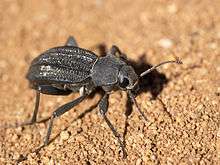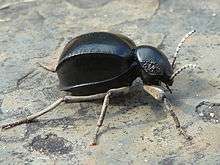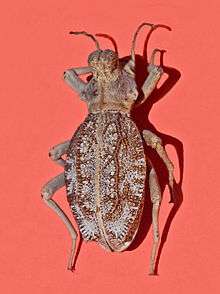Sepidiini
The Sepidiini is a tribe of ground-dwelling darkling beetles (Tenebrionidae),[1] that occurs across Africa, the Mediterranean Basin, the Arabian Peninsula and Mesopotamia. It is composed of many hundreds of species.[2] The larvae of some species are known to damage crops.[3]
| Sepidiini | |
|---|---|
 | |
| Somaticus aeneus, subtribe Trachynotina | |
| Scientific classification | |
| Kingdom: | Animalia |
| Phylum: | Arthropoda |
| Class: | Insecta |
| Order: | Coleoptera |
| Family: | Tenebrionidae |
| Subfamily: | Pimeliinae |
| Tribe: | Sepidiini Eschscholtz, 1829 |
| Subtribes | |
| |
| Synonyms | |
Morphology
Their morphology is complex due to their richly divergent forms.[2] They are distinguished from the diurnal taxa, by their well-developed and true hypomera of the elytra, the free mobility of the thorax and hind body, and the free and non-fused pleurital and pleural margins of the sterna and elytra respectively.[2]
Biology
Their morphology is believed to facilitate moisture absorption and accumulation, via the open body sutures and the loosely joined body parts. Subtribe Trachynotina excepting, they show an almost uniform tendency to be nocturnal, crepuscular or shade-loving.[2] Like the tribe Tentyriini, their daily rhythm is based on a strictly nocturnal ancestral disposition. Their open and non-connate body sutures suggest the enjoyment of nocturnal conditions and night moisture.[2]
At night, a surface secretion of a sometimes pruinescent or waxy substance has been noted on the bodies of genera Brinckia, Namibomodes, Synhimba and Ocnodes (or Phanerotomea). This is assumed to prevent evaporation.[2]
Taxonomy
The tribe Sepidiini is made up of 6 subtribes, about 55 genera, and more than 900 species. These genera belong to the tribe Sepidiini:[4][5][6]
- Amiantus Fåhraeus, 1870
- Argenticrinis Louw, 1979
- Arturium Koch, 1951
- Bombocnodulus Koch, 1955
- Brachyphrynus Fairmaire, 1882
- Brinckia Koch, 1962
- Cyrtoderes Dejean, 1834
- Decoriplus Louw, 1979
- Dichtha Haag-Rutenberg, 1871
- Dimoniacis Koch, 1958
- Distretus Haag-Rutenberg, 1871
- Echinotus Solier, 1843
- Epairopsis Koch, 1955
- Ethmus Haag-Rutenberg-Rutenberg, 1873
- Euphrynus Fairmaire, 1897
- Glyptophrynus Fairmaire, 1899
- Histrionotus Koch, 1955
- Huilamus Koch, 1953
- Hypomelus Solier, 1843
- Iugidorsum Louw, 1979
- Melanolophus Fairmaire, 1882
- Microphligra Koch, 1955
- Miripronotum Louw, 1979
- Moluris Latreille, 1802
- Namibomodes Koch, 1952
- Ocnodes Fåhraeus, 1870[4]
(= Phanerotomea Koch, 1958) - Ossiporis Pascoe, 1866
- Oxura Kirby, 1819
- Oxycerus Koch, 1955
- Palpomodes Koch, 1952
- Peringueyia Koch, 1958
- Phrynocolus Lacordaire, 1859
- Phrynophanes Koch, 1951
- Physophrynus Fairmaire, 1882
- Psammodes Kirby, 1819[4]
(= Parmularia Koch, 1955) - Psammophanes Lesne, 1922
- Psammoryssus Kolbe, 1886
- Psammotyria Koch, 1953
- Pterostichula Koch, 1952
- Sepidiopsis Gestro, 1892
- Sepidiostenus Fairmaire, 1884
- Sepidium Fabricius, 1775
- Somaticus Hope, 1840
- Stenethmus Gebien, 1937
- Stridulomus Koch, 1955
- Sulcipectus Louw, 1979
- Synhimba Koch, 1952
- Tarsocnodes Gebien, 1920
- Trachynotidus Péringuey, 1899
- Trachynotus Latreille, 1828
- Triangulipenna Louw, 1979
- Trichethmus Gebien, 1937
- Uniungulum Koch, 1962
- Vieta Laporte, 1840
- Vietomorpha Fairmaire, 1887
Gallery
.jpg)
Hypomelus sp., Hypomelina 
Dichtha sp.,
Molurina_(6041960893).jpg)
Phanerotomea sp., Phanerotomeina 
Sepidium sp.,
Sepidiina
References
- Bouchard, Patrice; Lawrence, J.F.; Davies, A.E.; Newton, A.F. (2005). "Synoptic Classification of the World Tenebrionidae (Insecta: Coleoptera) with a review of Family-group names" (PDF). Annales Zoologici. 55 (4): 499–53. Archived from the original (PDF) on 12 November 2012. Retrieved 24 July 2013.
- Koch, C. "The Tenebrionidae of Southern Africa, XXXII New Psammophilous species from the Namib desert" (PDF). Annals of the Transvaal Museum: 107–124. Retrieved 7 November 2013.
- Drinkwater, T.W. (1991). "Morphology of and key to the larvae of six somaticus spp coleoptera tenebrionidae". Journal of African Zoology. 105 (6): 509–536. Retrieved 6 November 2013.
- Kamiński, Marcin J.; Kanda, Kojun; Lumen, Ryan; Ulmer, Jonah M.; et al. (2019). "A catalogue of the tribe Sepidiini Eschscholtz, 1829 (Tenebrionidae, Pimeliinae) of the world". ZooKeys. 844. doi:10.3897/zookeys.844.34241.
- Bousquet, Yves; Thomas, Donald B.; Bouchard, Patrice; Smith, Aaron D.; et al. (2018). "Catalogue of Tenebrionidae (Coleoptera) of North America". ZooKeys (728): 1–455. doi:10.3897/zookeys.728.20602. ISSN 1313-2989. PMC 5799738. PMID 29416389.
- Bouchard, Patrice; Bousquet, Yves; Davies, Anthony E.; Alonso-Zarazaga, Miguel A.; et al. (2011). "Family-group names in Coleoptera (Insecta)". ZooKeys (88): 1–972. doi:10.3897/zookeys.88.807. ISSN 1313-2989. PMC 3088472. PMID 21594053.